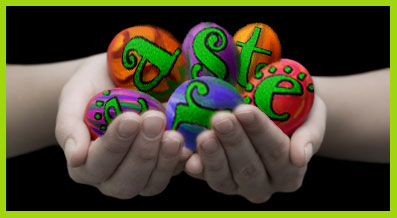WHY EASTER EGGS AND RABBITS?


Of all the symbols associated with Easter the egg, the symbol of fertility and new life, is the most identifiable. The customs and traditions of using eggs have been associated with Easter for centuries.In Germany eggs were given to children along with other Easter gifts.
Different cultures have developed their own ways of decorating Easter eggs. Crimson eggs, to honour the blood of Christ, are exchanged in Greece. In parts of Germany and Austria green eggs are used on Maundy Thursday (Holy Thursday). Slavic peoples decorate their eggs in special patterns of gold and silver.
Austrian artists design patterns by fastening ferns and tiny plants around the eggs, which are then boiled. The plants are then removed revealing a striking white pattern. The Poles and Ukrainians decorate eggs with simple designs and colorus. A number of eggs are made in the distinctive manner called pysanki (to design, to write).
Pysanki eggs are a masterpiece of skill and workmanship. Melted beeswax is applied to the fresh white egg. It is then dipped in successive baths of dye. After each dip wax is painted over the area where the preceding coloru is to remain. Eventually a complex pattern of lines and colours emerges into a work of art.
In Germany and other countries eggs used for cooking were not broken, but the contents were removed by piercing the end of each egg with a needle and blowing the contents into a bowl. The hollow eggs were dyed and hung from shrubs and trees during the Easter Week. The Armenians would decorate hollow eggs with pictures of Christ, the Virgin Mary, and other religious designs.
Just as Santa Claus represents Christmas, a hopping life-size bunny with a basket full of colorful eggs is the quintessential image of Easter.
The original Easter bunny was probably associated with the Pagan equinox festival that came before Easter. The Saxons devoted the month of April to celebrating their goddess of spring and fertility, who was, not coincidentally, named Eastre. Eastre’s sacred animal was the hare - not surprising since the rabbit is one of the most common symbols of fertility and rebirth.
The colored eggs carried by today’s Easter bunnies have another, even more ancient origin. Eggs have long been associated with fertility and springtime festivals - for so long, in fact, that the precise roots of the association are unknown. Ancient Romans and Greeks used eggs in festivals celebrating resurrected gods. The egg also featured prominently in the Jewish rituals of Passover - and still today the roasted egg has prominence on the seder table as an essential symbol of springtime and rebirth.
The next historical entry under Bunny & Egg is found fifteen hundred years later in Germany. There, children would eagerly await the arrival of the Oschter Haws, a rabbit who delighted children on Easter morning by laying colored eggs in nests. This was also the first known time that the rabbit and egg were linked together.
The German tradition of the Oschter Haws migrated to America in the 1800s, likely accompanying German immigrants, many of whom settled in Pennsylvania. Over the past 200 years, the Oschter Haws or Easter Bunny has become the most commercially recognized symbol of Easter.
Today American children squeal with delight when they see the bunny-whether he’s leading their neighborhood Easter egg hunt or greeting visitors at the local mall. The Easter bunny and his basket of eggs has become the most adored and recognized symbol of the Easter season.
0 comentarios